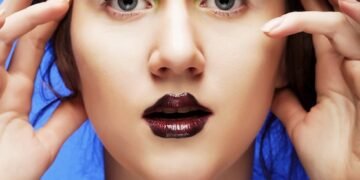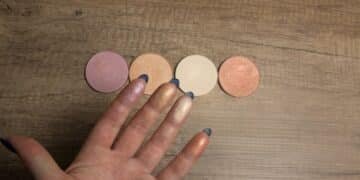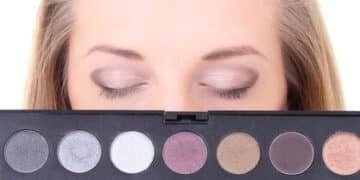The Complete Guide to Color Correcting: Achieve a Flawless Base in 2025

Color correcting is a makeup technique that uses specific shades to neutralize unwanted tones on the skin, creating an even base for foundation application and resulting in a flawless complexion in 2025.
Ready to say goodbye to unwanted redness, dark circles, and dullness? The Complete Guide to Color Correcting: How to Neutralize Imperfections for a Flawless Base in 2025 unveils the secrets to achieving a perfectly even complexion, setting the stage for a flawless makeup look.
Understanding the Color Wheel for Effective Color Correcting
Color correcting is based on the principles of the color wheel. Understanding how colors interact with each other allows you to effectively neutralize imperfections. By using colors opposite each other on the color wheel, you can cancel out those unwanted tones in your skin.
The color wheel is your best friend when it comes to understanding color correcting! Let’s see what we can do with it.
The Magic of Opposites
The concept of using colors directly opposite each other on the color wheel to neutralize one another may seem obscure, but it is actually quite logical, particularly in the realm of makeup. This color theory operates on the premise that when two complementary colors are combined, they effectively diminish or nullify each other’s intensities. For instance, if you have redness in your complexion, such as acne, scars, or rosacea, applying a green color corrector will help to counteract the redness; this is because green sits directly across from red on the color spectrum. Once the green corrector is gently applied, it balances out the area, reducing the visibility of the redness and providing a more even skin tone.
Similarly, purple and yellow are another set of opposites. If you notice your skin appears dull or has yellow undertones, particularly in areas of discoloration or freckles, a lavender or purple-toned corrector can brighten these areas and restore a natural, vibrant look. The principle extends to other colors as well, allowing you to customize your makeup to target specific areas of discoloration with precision.
Which Colors to Use
Here are the basic colors you would use as part of your makeup routine:
- Green: Neutralizes redness from acne, rosacea, or sunburn.
- Peach/Orange: Corrects dark circles and discoloration in fair to medium skin tones.
- Yellow: Brightens dullness and cancels out purple or blue undertones.
- Lavender: Corrects sallowness and brightens olive or yellow skin tones.
- Red/Pink: Brightens dark circles and discoloration in deep skin tones.
By understanding the basic colors, you will properly cover up any marks on your face. No one will ever know!
Mastering the color wheel is the first step in achieving a flawless base. Once you understand the basic principles, you’ll be able to address any imperfections with confidence.
Choosing the Right Color Corrector for Your Skin Tone and Concern
The effectiveness of color correcting heavily depends on selecting the correct shade and formulation for your specific skin tone and concern. A universal approach simply doesn’t work; what works for one person may not work for another. Factors such as skin tone, the severity of the discoloration, and the type of product all play crucial roles in achieving the desired outcome.
A range of color correctors is available from pressed powders to liquids and creams, but how do you choose the right one?
Skin Tone Considerations
Fair skin tones often benefit from peach or light orange correctors to address under-eye circles or hyperpigmentation. Medium skin can use peach, orange, or even yellow correctors depending on the specific discoloration. Darker skin tones may require deeper orange, red, or even brown tones to effectively conceal dark spots or hyperpigmentation. You might even want to experiment with different types until you find the perfect fit.
Addressing Specific Concerns
Consider the formulation as well. For minor redness from occasional acne, a lightweight green concealer might suffice. For more severe rosacea or extensive redness, a color-correcting primer could be more effective in neutralizing the skin tone across a larger area. Under-eye circles can be tricky, as they can sometimes appear blue or purple due to visible veins under the skin. A peach or salmon-colored corrector containing hydrating ingredients can help brighten the area and prevent the concealer from creasing.
Here are some further tips on choosing the correct formulation:
- Dry Skin: Cream or liquid correctors provide hydration and prevent caking.
- Oily Skin: Powder correctors absorb excess oil and prevent shine.
- Combination Skin: Balance cream and powder formulas or use a long-wearing liquid.
The correct color corrector will allow you to brighten your face to just the tone you desire. Once you get the hang of it, you’ll find that adding color corrector will give you the perfect complexion and glow. A little goes a long way!
Step-by-Step Guide to Applying Color Corrector Like a Pro
Applying color corrector correctly can make all the difference in whether your makeup looks flawless or cakey. The key is to use a light hand and blend thoroughly to avoid creating a visible layer of color under your foundation. Whether you’re prepping for a big night out or just trying to even out your complexion, mastering the application process is essential.
But where do you start? Thankfully, here is a step-by-step guide to make the process simple and easy.
The Correct Order
Start with a clean, moisturized face. Apply primer to create a smooth base for the color corrector. This step will also help the color corrector adhere better and last longer throughout the day. Next, use a small brush or your fingertip to apply the color corrector directly to the areas of concern. Remember to use a light hand and build up the coverage as needed.
Then, gently blend the edges of the color-correcting product into the surrounding skin, using a tapping or stippling motion rather than rubbing. This technique helps to avoid disturbing the product underneath and ensures a seamless transition. Once the color corrector is fully blended, allow it to set for a minute or two before moving on to the next step.
Applying Your Foundation
Now you are ready to apply your foundation. Use your preferred method – whether it’s a sponge, brush, or your fingertips – to apply your regular foundation over the color-corrected areas. Again, use a light hand and build up the coverage gradually to avoid moving or disrupting the color corrector underneath. It is important to start with a thin layer of foundation and add more only where needed. If necessary, use a concealer in a shade that matches your skin tone to further perfect any remaining imperfections or to brighten the under-eye area.

By using the right order, you’ll be able to create a flawless look with no visible makeup underneath. You will look as though you have perfect skin!
Common Mistakes to Avoid When Color Correcting in 2025
Color correcting can dramatically improve the look of your makeup, but it’s also easy to make mistakes that can lead to an unnatural or even unflattering result. Avoiding these common pitfalls will ensure your makeup looks polished and professional.
Let’s focus on some common mistakes you should look out for.
Over-Applying Product
One of the most common mistakes is applying too much color corrector. This can result in a cakey or heavy look, and the color corrector may be visible through your foundation. Use a light hand and build up the coverage as needed, focusing only on the areas that need correction. Instead, use a minimal amount and add more in layers if necessary. Remember, it’s much easier to add product than to take it away.
Incorrect Colors
Using the wrong color corrector can actually worsen the appearance of your skin. For instance, using a green color corrector on dark circles can make them appear ashy or gray. Always refer to the color wheel to ensure you are using the correct color to neutralize the specific discoloration you’re targeting. If you are unsure, it’s best to consult a makeup artist or do some research online to find the right color for your skin tone and concerns.
Poor Blending
Poor blending is another common mistake that can ruin your entire makeup look. If the edges of the color corrector are not properly blended, they will be visible through your foundation, creating harsh lines and an unnatural appearance. In fact, blending the makeup will create the most perfect look.
Avoiding these mistakes will help you achieve a natural, flawless makeup look. Here are some general tips to improve your overall look:
- Always Blend: Blend, blend, blend, and then blend some more.
- Right Colors: Make you use the correct colors for maximum impact.
- Experiment: Find out your perfect look, and practice often!
Don’t get discouraged, and keep practicing. You will eventually get the perfect look.
Tools and Products for Successful Color Correcting
Having the right tools and products can make color correcting much easier and more effective. Investing in high-quality items will not only improve the application process but also ensure that your makeup looks flawless and lasts longer. From brushes to correctors, each tool or product you use plays a role in achieving a balanced and even-toned complexion.
So, what are the tools and products you should be looking out for?
Essential Brushes
Using the right brush can help you apply the color corrector precisely and blend it seamlessly into your skin. Small, pointed brushes are ideal for targeting specific areas, like blemishes or dark spots, while larger, fluffy brushes are better for blending larger areas, such as the cheeks or forehead. Choose brushes with soft, synthetic bristles to avoid irritating your skin and to ensure even application of the product.
Recommended Products
There are numerous excellent color correcting products available on the market, ranging from creams and liquids to powders and sticks. It’s important to choose products that suit your skin type and address your specific concerns. For example, if you have dry skin, opt for cream-based correctors that provide hydration, whereas powder formulas are more suitable for oily skin as they help to absorb excess oil and prevent shine.
Product Brands
Here are some awesome brands to consider:
- NYX Professional Makeup: Known for its affordable and high-quality color-correcting palettes.
- Urban Decay: Offers a range of color-correcting fluids and concealers.
- MAKE UP FOR EVER: Provides a variety of professional-grade color-correcting products.
Remember, investing in the right tools and products can elevate your color correcting game and ensure a flawless makeup look. With the right equipment and a bit of practice, you’ll be able to achieve a perfectly even complexion every time.
Advanced Techniques and Tips for Color Correcting in 2025
As you become more comfortable with color correcting, you can start experimenting with advanced techniques to achieve an even more polished and refined look. Mastering these tips and tricks will allow you to customize your makeup application to address unique skin concerns and create a flawless, professional-looking finish.
Ready to up your game?
Layering Colors
Layering different color correctors can be an effective way to address multiple concerns simultaneously. For example, if you have both redness and dark circles, you can first apply a green color corrector to neutralize the redness, followed by a peach or orange corrector to brighten the under-eye area. Just make sure to blend each layer thoroughly to avoid creating a heavy or cakey finish.
Mix Colors
You can mix different color correctors to create a custom shade that perfectly matches your skin’s needs. For instance, you can mix a small amount of green color corrector with a moisturizer or primer to create a tinted base that neutralizes redness all over your face. Or, if you have trouble finding the perfect shade of peach or orange corrector for your dark circles, you can mix a couple of different shades together to achieve the desired color.

Setting Everything
Always set your color-corrected makeup with a translucent powder to prevent creasing and ensure long-lasting wear. Use a soft brush or a makeup sponge to gently press the powder into the skin, focusing on areas that are prone to creasing or shine, such as the under-eye area or the T-zone. This step will not only help to set your makeup but also create a smooth, flawless canvas for the rest of your makeup application.
Here are some of the greatest advanced tips to keep in mind:
- Experiment With Different Shades: Find out some hidden gems.
- Blend All of The Colors Perfectly: It’s important to blend it all precisely.
- Try The Great Mix and Match: Find what is the perfect fit to give you a boost.
With some practice, you can get the most perfect base without anyone even noticing!
| Key Tip | Brief Description |
|---|---|
| 🎨 Color Selection | Use colors opposite on the wheel to neutralize (e.g., green for redness). |
| 🖌️ Application | Apply lightly, focusing only on areas needing correction, using a small brush. |
| 🔄 Blending | Blend thoroughly to avoid harsh lines; use tapping motions for seamless integration. |
| ✔️ Product Selection | Choose products based on skin type: creams for dry, powders for oily. |
Frequently Asked Questions
▼
Color correcting neutralizes discolorations on the skin, such as redness, dark circles, and sallowness. Correctors provide an even skin tone for better makeup application.
▼
No, color corrector is only necessary when you have significant discolorations that need to be neutralized. If you have a relatively even skin tone, you can skip this step.
▼
If you don’t have a green color corrector, you can use a green-tinted primer or concealer. Alternatively, you can try a light layer of green eyeshadow, but be sure to blend it well.
▼
Concealer can help cover minor discolorations, but color correctors are designed to neutralize specific tones. For significant concerns, color correcting products will typically provide a better result.
▼
If the color corrector is visible underneath your foundation or your makeup looks cakey, you’ve likely used too much. Remove excess product by gently blotting with a makeup sponge or tissue.
Conclusion
Mastering the art of color correcting can transform your makeup routine, helping you achieve a flawless and even complexion. By understanding the color wheel, choosing the right products, and practicing the application techniques, you can confidently neutralize imperfections and enhance your natural beauty.





